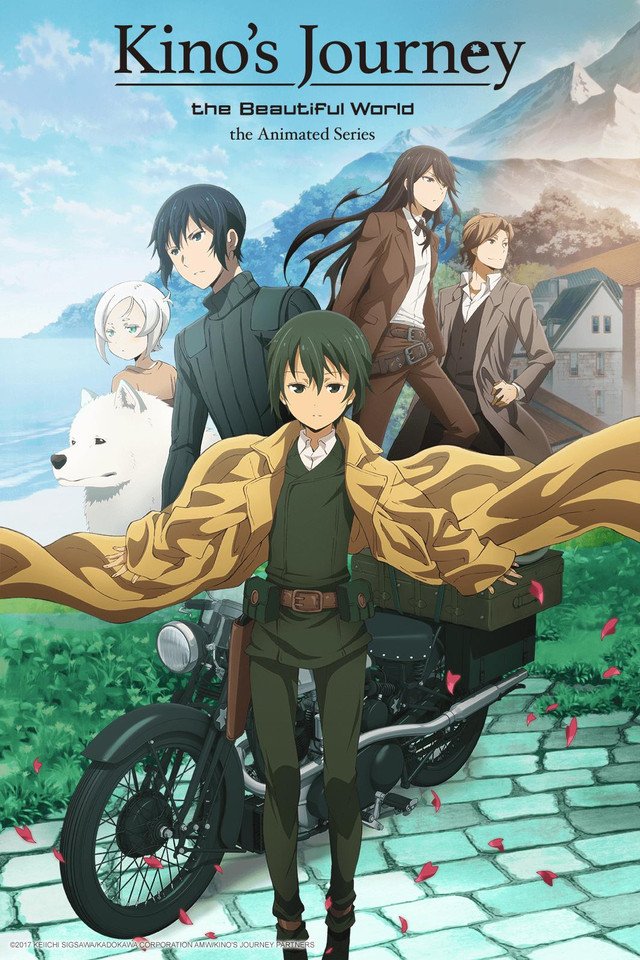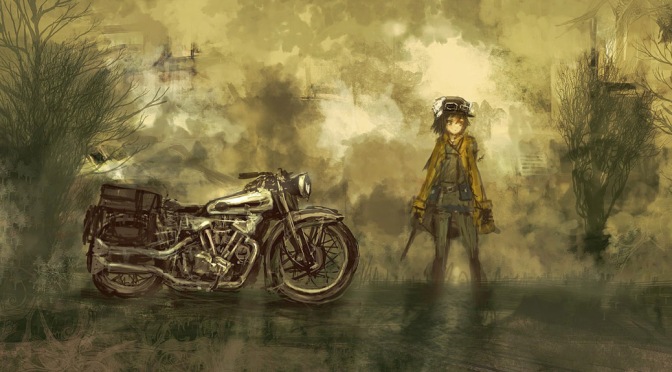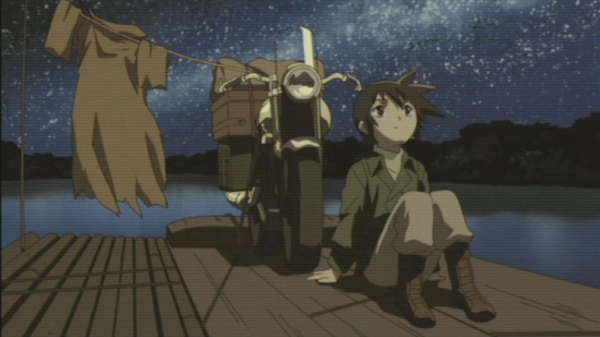SUPERVERSIVE: “Kino’s Journey” 2003 is a forgotten classic
Wednesday , 15, April 2020 Uncategorized Leave a commentKino and Hermes as portrayed in the 2003 anime
The world is not beautiful; and that, in a way, lends it a sort of beauty.
I thought I didn’t like “Kino’s Journey”, despite its reputation as a minor classic.
Years ago I watched the first episode and was unimpressed. It was slow moving and philosophical, and at the time I found it dull and quickly lost interest.
Yet I never quite forgot the show. Something about the premise, a lone girl traveling from country to country with her trusty talking motorcycle Hermes, fascinated me: What was her journey about? What was she doing?
So years later, I tried again.
And I finished the series in two days.
And I can’t stop thinking about it.
This show earned its reputation.
“Kino’s Journey” is different from anything I’ve ever seen. It’s not an action show. It’s not an adventure show. It isn’t slice of life. It’s ALMOST a series of fables, though not quite. It keeps a sense of reality through the character of Kino, who has a personality and a past she frequently references, and who reacts to the world like a real person. In the 2017 remake – which is still based on stories from the original light novel series – other main characters appear that sometimes star in their own episodes, and there’s even genuine character development.
So it can’t be called a series of fables in the strictest sense.
But what is “Kino’s Journey”? I suppose if I were to try and boil it down to its base appeal, it’s an exploration of different philosophies. Kino – at least, normally Kino – enters a country, where she stays for three days. While there, she learns of that country’s particular customs, and the show explores the logic behind their unusual laws or distinct ways of living – what drives the people to act the way they do.
 Kino is as a rule an observer who avoids getting involved; the point of the journey, if there can be said to be a point, is to examine other perspectives objectively. But Kino is a human being, and if she believes there is a way she can help, she won’t hesitate to act. This is what moves the show beyond fable into a genuine story about an active person who drives the plot rather than letting it happen around her (in fact, this very aspect of Kino’s personality is the subject of an episode exploring travelers and the reasons they travel).
Kino is as a rule an observer who avoids getting involved; the point of the journey, if there can be said to be a point, is to examine other perspectives objectively. But Kino is a human being, and if she believes there is a way she can help, she won’t hesitate to act. This is what moves the show beyond fable into a genuine story about an active person who drives the plot rather than letting it happen around her (in fact, this very aspect of Kino’s personality is the subject of an episode exploring travelers and the reasons they travel).
Okay, okay. I’m getting off track. The best way to explain this is simply to tell you what an episode is like:
“A Peaceful Land” – Kino travels to a country that claims to be peaceful, but is preparing for a battle the very next day. Curious, Kino speaks to the history museum’s curator and learns they were at war with a neighboring country for over 200 years, but developed a system where fighting would only occur once a year, and nobody in either country would die. Kino observes the battle the next day and is horrified with what she sees.
This is Kino’s Journey at its finest. I’m not spoiling what happens next, because it is much more powerful to see it in action. There are no answers. There’s no happy ending. There is the story, the people, the actions they take, and the consequences.
What does it all mean? Well, it’s up to the viewer to decide.
Mind you, not every story is dark. Some are whimsical, like the story about a young woman who invents a flying machine. Some are heartwarming. Some are heartbreaking. Some are merely think-pieces, not emotional but fascinating nevertheless. One excellent example is the Land of Visible Pain, about a country where everybody knows everyone else’s thoughts all the time.
“Kino’s Journey” is a story whose main appeal is undoubtedly its writing, but there is still something to be said for it visually. The animation isn’t great, but the art style is distinct in a charming way, and the direction and use of colors is excellent. The series has a style to it that I believe is beautiful in its own way, even if there’s little sakuga to look it.
There is a 2017 anime adaptation of “Kino’s Journey” as well. In my opinion, it is not as good. The animation is, on a technical level, better, and the art more polished, but it lacks the distinct style and excellent direction of the original. It looks good, occasionally even great, but it looks like a bog-standard anime for a show that is very much NOT bog-standard.
That said, I recommend it to fans of the 2003 version. It mostly adapts new stories from the light novel series. Three episodes are remakes, all some of the best stories from the original anime; I have seen two so far and neither are as good as the original versions of the story. The Coliseum episode of the 2017 anime is an especially poor adaptation. “Kind Country”, the new adaptation of the original classic episode “A Kind Land”, loses some of the subtlety of the ending (and in my opinion makes Hermes sound vaguely sociopathic); it is by no means a bad adaptation, but between the two the original is certainly better.
 Despite this, some of the new stories, like “Country of Liars”, from a writing perspective at least, are just as good as the best episodes from the original show, and the introduction of new regular characters turns out to be a welcome change of pace. The 2017 “Kino’s Journey” is undoubtedly worth watching by fans of Kino, but I would only watch it after you finish the 2003 anime.
Despite this, some of the new stories, like “Country of Liars”, from a writing perspective at least, are just as good as the best episodes from the original show, and the introduction of new regular characters turns out to be a welcome change of pace. The 2017 “Kino’s Journey” is undoubtedly worth watching by fans of Kino, but I would only watch it after you finish the 2003 anime.
Unfortunately, only the first “Kino’s Journey” light novel has been translated into English, and there’s no kindle version; the cheapest you can find on Amazon is over 20 dollars, which in the modern day is rather expensive for a book that old. You CAN get manga adaptations, one of which is only 99 cents, so if that’s your thing the option is available to you.
“Kino’s Journey” will not be for everyone, but I would encourage everyone to give it a chance, and perhaps for a couple of episodes. There is something unique about it, something truly fascinating, and at its best “Kino” sticks in your mind long after the credits roll, its stories haunting you. They rattle around your brain as you try to process what you saw, make you really think, and I don’t think I’ve ever seen a show or even read a book as good at accomplishing that goal. And its profundity is in its lack of answers, its presentation of ideas.
There’s really nothing else like it. “Kino’s Journey” is highly recommended.


Please give us your valuable comment